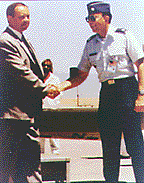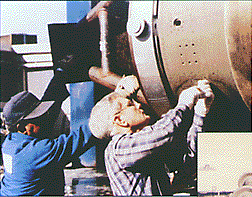| ELIMINATING
THE INF MISSILES
Lt. Colonel Stephen B. Boyd, USAF, was a senior American escort team leader who participated in more than 50 INF Treaty inspections. An experienced field grade officer, he had served in strategic missiles, missile maintenance, officer training, and tactical missiles, prior to his assignment as the deputy, then commander, of the On-Site Inspection Agency's San Francisco Field Office. Colonel Boyd and his staff had responsibility for escorting all Soviet INF inspection teams in the western United States from July 1988 through June 1992. On preparing for a Soviet INF inspection team: "The treaty, obviously, was the pivot point for everything we do. In managing, it's best to set a certain reference point. Then management starts in earnest when we anticipate a Soviet inspection. For the eliminations, we knew a month in advance; that's when we in the field office went into high gear. I'd say that probably 75 percent of what I personally had to do was to take care of the logistical matters. We had to set up a secure area for billeting, establish a means for feeding the Soviet inspectors, and then plan out the entire movement of the team for what we anticipated would be a ten day (elimination) event." On the early days: "We operated on promises. They (Travis Air Force Base officials) trusted us that we would pay them back. We got vehicles, for example. We would go down to the motor pool, and they would say, how many do you need? Vehicles are always a scarce commodity; yet they gave them up for the INF mission. We also got an entire block of VOQ rooms for six weeks for our TDY people. I was, frankly, surprised because most bases jealously guard their resources." On using military airlift: "We kind of grew with the system. I don't know who did it, but someone set up a good liaison with the Military Airlift Command. Sometimes on the ground we'd anticipate the Soviet inspectors being there a short period of time (closeout inspections), but other times it could be a full 24-hour period (short-notice inspections). As it turned out, the Soviets spent almost 24 hours on each of the sites. The airlift has worked flawlessly." On the Soviet INF inspection teams: "The Soviets, at least the ones that I have been in contact with, have been very diplomatic, rational, and logical. Let me tell you about two instances, both at Davis Monthan. In the first, the Soviets looked at several GLCM missile trainers, and they were of different configurations because they had slightly different training objectives. One of them had a fuel bladder that was used for fueling/defueling training; the others looked like standard missile trainers. The Soviet inspectors were concerned that we had different modifications, or different models of the GLCM missiles. They spent what I considered a considerable amount of time, an hour or so, discussing why these trainers were different in appearance. I explained, and the Air Force people on site explained to them, that the trainers had different training objectives within the same missile system." "On another occasion, there were several GLCM canisters which differed in appearance from the standard MOU photographs. These missiles had been deployed overseas. The ones the Air Force displayed for this inspection, at Davis-Monthan were 20 inches shorter. The Soviet inspectors were concerned because the missiles presented did not look like those in the pictures from the official Memorandum of Understanding. On both occasions, the Soviets did not accuse us of anything, nor did they imply that we were trying to pull anything over on them. They just simply asked what I considered to be very logical questions. I inferred from their questions what their concerns were, which was that the U.S. had more models of GLCM missiles than we had advertised. That was not the case. In their inspection report they did not address these differences as treaty ambiguities; they simply made notes in the report that not all of the trainers had the same configuration as stated in the Memorandum of Understanding." Source: Interview, April 3, 1989 |

